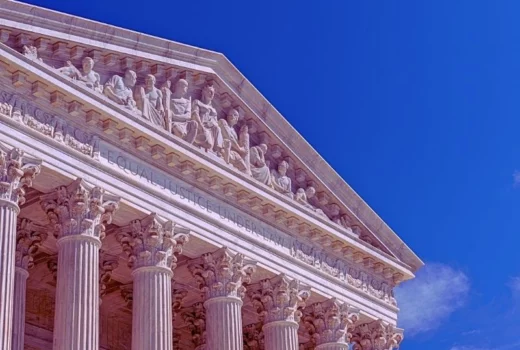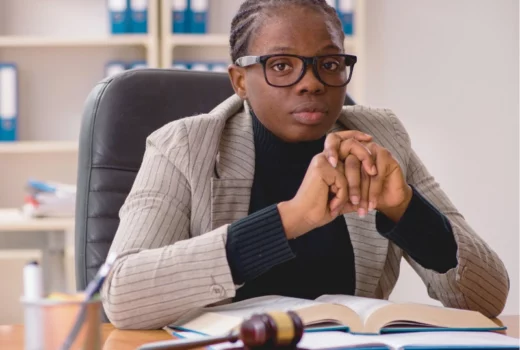
The American Lawyer released its annual A-List rankings of the top 20 “most well-rounded” law firms in the United States. According to the report, law firms are ranked based on a combination of financial and cultural factors including revenue per lawyer, pro bono commitment, racial diversity, associate satisfaction and gender diversity among the equity partnership level. The last metric was added to A-List’s calculation in 2017 to recognize firms for supporting women and making them partners.

In a year that’s been marked by upheaval and uncertainty, there’s also plenty of continuity in the upper reaches of the A-List. For the second year in a row, Munger Tolles & Olson claimed the No.1 spot on this year’s list, while landing in the top five for a fifth time in the last five years. Ropes & Gray landed the No. 2 spot, improving across all five categories, most notably associate satisfaction. At O’Melveny & Myers, improvements in the firm’s metrics for racially diverse attorneys and women in the equity partnership fueled a four-place jump into the No. 3 position, marking the firm’s third straight year in the Top 10 and its fifth time on the list in the last five years.
Los Angeles-based Manatt, Phelps & Phillips returned to this year’s list following two years off, rising seven places to No. 15, thanks to a 20.5-point improvement in the female equity partner category. Two more firms new to this year’s A-List rankings included Cravath Swaine & Moore (No.17), and Arnold & Porter (No.19). A few firms on the list made last year’s Top 20 but faced shortcomings in vital areas, forcing them off in 2020. Those four firms were Shearman & Sterling, Buckley, Milbank, and Simpson Thacher & Bartlett.
See more highlights from the A-List rankings on The American Lawyer.
Contact Bill Sugarman, a legal recruiter, for more information.
The American Lawyer released its annual A-List rankings of the top 20 “most well-rounded” law firms in the United States. According to the report, law firms are ranked based on a combination of financial and cultural factors including revenue per lawyer, pro bono commitment, racial diversity, associate satisfaction and percentage of female equity partners.

Munger Tolles ranked No. 1 on this year’s A-List. Climbing from last year’s No. 3 spot, the firm moved up due to high scores in revenue per lawyer, pro bono work, and number of female equity partners. Wilmer Cutler remained in the No.2 spot, improving in four of five categories. Slipping from 1st place last year, Ropes & Gray landed spot No. 3, declining across all categories. Washington, D.C.-based Buckley jumped nine spots to move onto this year’s A-List at No. 17, improving in three of the five categories, most notably associate satisfaction.
New firms added to this year’s A-List rankings included Hughes Hubbard & Reed (No.11), Gibson Dunn (No.13), and Buckley (No.17). A few firms on the list made last year’s Top 20 but faced short comings in vital areas, forcing them off in 2019. Those three firms included Akin Gump (No. 23), Patterson Belknap (No. 29), and Jenner & Block (No. 30).
Additionally, The American Lawyer released a list of the next 20 A-List firms (No. 21-40), The A-List Runners-Up. Washington D.C.-based Williams & Connolly jumped 35 spots to land 21st place, due to high scores in associate satisfaction, revenue per lawyer, and female equity partners. Appearing for the first time on this list, Proskauer Rose claimed 25th place, thanks to large improvements in associate satisfaction and female equity partners. Cravath Swaine & Moore jumped 16 spots to land 26th place, improving across all categories, particularly in revenue per lawyer, diversity and pro bono.
See highlights from the full article on The American Lawyer.
Contact Bill Sugarman for more information.
The American Lawyer released its annual A-List rankings of the top 20 “most well-rounded” law firms in the United States. Firms are ranked based on a combination of factors including revenue per lawyer, pro bono commitment, racial diversity, associate satisfaction and percentage of female equity partners.

Ropes & Gray ranked No.1 on this year’s A-List. Climbing from last year’s number two, the firm moved up thanks to high scores in revenue per lawyer, pro bono work, and number of female equity partners. Wilmer Hale climbed two spots to claim this year’s No.2 spot with high scores in almost all categories. Slipping from 1st place last year, Munger Tolles landed spot No.3, declining in all categories, particularly in the female equity partners category. Orrick Herrington moved six spots to claim 4thplace, thanks to high scores in pro bono, associate satisfaction and female equity partners.
New firms added to this year’s A-List rankings included Morrison & Foerster (No.11), Patterson Belknap (No.17), Morgan Lewis (No.18), and Jenner & Block (No.19). A few firms on the list made last year’s Top 20 but faced shortcomings in vital areas, forcing them off in 2018. Those firms included Gibson Dunn (No.22), Hughes Hubbard & Reed (No.29), and Manatt Phelps & Phillips (No.30).
Additionally, The American Lawyer released a list of the next 20 A-List firms (No. 21-40), The A-List Runners-Up. Washington, D.C.-based Buckley Sandler jumped 25 spots to land 26th place, due to large improvements in RPL, female equity partners, and associate satisfaction. Appearing for the first time on this list, Arnold & Porter Kaye Scholer claimed 31st place, thanks to an impressive score in the pro bono category. Dechert climbed 10 places to land the 34th spot on this year’s list, due to increases in its associate satisfaction and diversity scores.
See highlights from the full article on The American Lawyer.
Contact Bill Sugarman for more information.
The American Lawyer reports that recent data released by ALM Intelligence shows female attorneys have ascended into Big Law’s partnership ranks at a faster pace than ever before in the wake of the #MeToo movement. According to the analysis, the pace of promotions for female lawyers since the #MeToo movement began has soared from 125 per month to 265 a month —or more than double the rate from the previous period.

Mary Leslie Smith, who became managing partner of Foley & Lardner’s Miami office earlier this year, notes that the movement has raised awareness. “What the Harvey Weinstein and #MeToo movement has done is raise awareness,” Smith said. “Firms began to look internally and ask, ‘Are we doing right by our women?’”
In addition, the article reports on several high-profile elevations of women in Big Law including Donna Wilson, named to become CEO and managing partner of Manatt, Phelps & Phillips in July 2019; Julie Jones, who will become the first female chair of Ropes & Gray at the end of 2019; and Patricia Brown Holmes, who became managing partner of Riley Safer Holmes & Cancila in April.
Debra Baker, a lawyer and managing director at GrowthPlay, concludes that “the most significant force now encouraging firms to promote women is an increased demand by clients for diversity. Clients are looking for diverse lawyers, not just to appear politically correct, but because they want advisers that know something about their businesses, will share fresh perspectives and work collaboratively, added Baker, noting that women often do better on those fronts since they “tend to score higher on social sensitivity.”
See highlights from the full article on The American Lawyer.
Contact Bill Sugarman for more information.
The American Lawyer released its 15th annual A-List rankings of the top 20 “most well-rounded” law firms in the United States. Firms are ranked based on a combination of factors including revenue per lawyer, pro bono commitment, racial diversity, associate satisfaction and percentage of female equity partners.

Munger Tolles ranked No. 1 on this year’s A-List. Climbing from last year’s number two, the firm moved up thanks to high scores in diversity, pro bono work, and number of female equity partners. Ropes & Gray came in second place on the A-List with high scores in almost all categories except for diversity. Paul, Weiss jumped 23 spots to claim the No.3 spot, thanks to a strong female equity score and significant increase in associate satisfaction. Kirkland & Ellis landed spot No. 17, slipping from 8th place last year, due to a decrease in its associate satisfaction and diversity scores. Skadden Arps moved up four spots to claim 12th place, thanks to an increase in its associate satisfaction and pro bono scores.
New firms added to AmLaw’s A-List were Paul, Weiss (No.3), Sherman & Sterling (No.8), Simpson Thacher & Bartlett (No.14), Manatt, Phelps & Phillips (No. 15), Arnold & Porter (No.16), and Hughes Hubbard & Reed (No.19).
Additionally, The American Lawyer released a list of the next 20 A-List firms (No. 21-40), The A-List Runners Up. A few firms on the list made last year’s Top 20 but faced shortcomings in vital areas, forcing them off in 2017. Those firms were Morrison & Foerster (No. 22), Jenner & Block (No. 23), Sullivan & Cromwell (No. 24), Willkie Farr & Gallagher (No. 25), and Cleary Gottlieb Steen & Hamilton (No. 26).
See the full report and article on The American Lawyer.
Please contact Bill Sugarman, a legal recruiter, for more information.
Law360 released its fourth annual Glass Ceiling Report, which surveyed 300 law firms on gender diversity and ranked firms based on the percentage of female equity partners in the United States.

According to the report, women make up just 34% of all attorneys and 23% of partners in law firms across the country. Law360’s editor in chief, Anne Urda, notes, “Intentions among law firms are good, and some slight progress has been made, but overall the numbers indicate that law firms need to do much more to close the gap among male and female associates and partners.”
Firms with the highest levels of female equity partners tend to focus on building a clear pipeline to equity partnership for women and offering benefits like work schedule flexibility, mentorship programs and greater leadership opportunities in order to retain top-performing attorneys.
Among the 300 law firms surveyed, small firms (20-149 attorneys) had the highest percentage of female equity partners, including Adelson Testan (60%), Walsworth (57.1%), Stokes Lawrence (43.5%), Berry Appleman (42.9%) and Verrill Dana (41.5%).
For medium to large sized firms (150-599 attorneys), the top five best firms for female partners were Fragomen (40.7%), Miller Nash (37.7%), Hanson Bridgett (37.1%), FordHarrison (33.3%) and Chapman & Cutler (31.2%).
In the biggest category of ‘Big Law’ firms (600+ attorneys), firms with the highest percentage of female equity partners were Littler (28.5%), Faegre Baker (27.2%), Jackson Lewis (26.1%), WilmerHale (25.1%), and Ropes & Gray (25%).
See the full article and rankings on Law360.
(Subscription required to access full articles.)
Contact Bill Sugarman for more information.
Finding a foothold in the Chicago market isn’t as easy for the elite ‘big law’ firms as they might like to believe, reports Claire Bushey of Crain’s Chicago.

The article looks at three national firms that had big aspirations for growth upon their respective moves to Chicago: Paul Hastings, Ropes & Gray, and Morgan Lewis & Bockius. New York-based Paul Hastings, for example, opened its Chicago doors in 2006, initially recruiting top partner talent and reporting goals of a 100+ lawyer office. Ten years later, the office boasts of only 42 attorneys. Former managing partner of the office, Rick Chesley, says that its the tough Chicago competition that forces firms to really consider their client base: “If you haven’t thought about who your clients are, who you’re going to compete with…you’re going to fail,” he said (as quoted in Crain’s).
Similarly, Boston-based Ropes & Gray opened eight years ago with predictions of a 100-lawyer headcount within two years. The Chicago office has only 64 attorneys to date–a stark contrast to their London office, which went from 2 attorneys at their 2010 opening to 129 today.
Anthony Nasharr, Managing Partner of the Chicago office of Polsinelli, believes that firms looking to expand into Chicago need to be “chasing work characteristic to the city, like agribusiness or financial services” (as quoted in Crain’s). Polsinelli, a firm headquartered in Kansas City, has proven that they have the right approach for Chicago growth, successfully growing their six-attorney starter office to almost 100 in just eight years. Nasharr also notes that a new Chicago office requires strong support from their headquarters to help the office thrive–like supplying the funds to bring on quality lateral partners. Much Shelist Managing Partner Mitchell Roth agrees that the need for good talent is critical to success in any major market, but argues that acquiring that talent can prove difficult: “To open a five-person office and expand to 100 in one or two years, when everyone’s trying to buy the exact same talent? It’s next to impossible,” he says (as quoted in Crain’s).
Despite the difficulties, six out-of-town firms merged with Chicago firms last year–more than in any other city, Crain’s reports. However, former Kirkland & Ellis partner Steven Harper warns the newcomers not to be fooled into thinking their high-profile reputations will be their be-all, end-all for attracting clients: “These firms believe that…clients will flock to the brand. Well, maybe not. Probably not,” he cautions (as quoted in Crain’s).